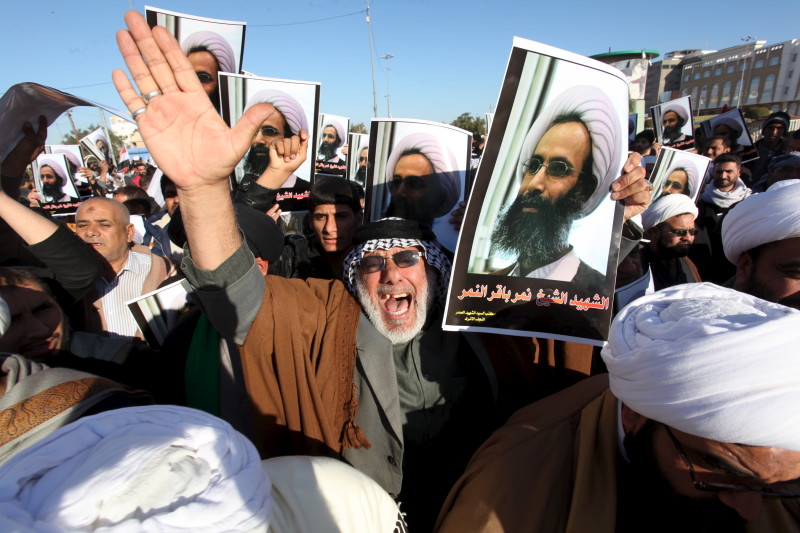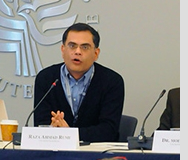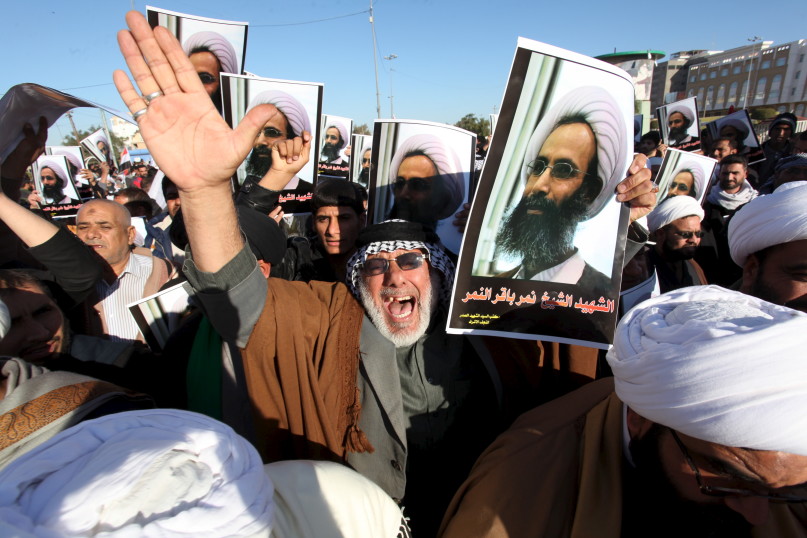
Iraqi men protest against the execution of Shiite Muslim cleric Nimr al-Nimr in Saudi Arabia, during a demonstration in Najaf on Jan. 4, 2016. Photo by Alaa al-Marjani, courtesy of Reuters.
(RNS) Saudi Arabia’s execution of Shiite cleric Nimr al-Nimr has stoked tensions with its archrival Iran and escalated the risk of a wider regional conflict. After violent attacks on Saudi diplomatic missions in Iran, Saudi Arabia severed diplomatic ties and expelled Iranian diplomats. Meanwhile, Sunni nations in the Gulf have also downgraded diplomatic relations with Iran.
The standoff is political, but rooted in the political history of Islam. The strict Wahhabi-influenced Sunni kingdom of Saudi Arabia and hard-line Shiite Iran have, for decades, competed for the leadership of the Islamic world. And they have used sectarian divides to further their own regional ambitions.
After the death of the Prophet Muhammad in the year 632, divisions over succession dogged the nascent Muslim state. The dominant group elected Abu Bakr, a companion of Muhammad, to be the first caliph, or ruler, and sidelined the claim by another group that had proposed Ali ibn Abi Talib, Muhammad’s cousin and son-in-law. The term Shiite is related to shi’atu Ali, (or followers of Ali) and the adherents of this creed hold that Ali and his descendants were unfairly treated. They also stress that the prophet’s family is central to the divine order of Islam. Ali, however, became caliph in 656; and five years later he was murdered.
RELATED STORY: The ‘Splainer: Islam’s Sunni/Shiite divide
When Hussain, son of Ali — and grandson of the prophet — was killed in 680 in a battle at Karbala, in present-day Iraq, the city become the symbol of Shiite resistance. Sunni rulers worried about the backlash and another cycle of violent persecution of Shiites began.
Domination of Sunni Muslim rulers continued for nine centuries (except in 10th- and 11th-century Egypt). It was only in 1501 that a Safavid dynasty in Persia adopted Shiite Islam as the state religion and the Safavids battled Ottoman caliphs for supremacy. The geographical and political legacies of those times define the current demographic division of the Muslim world. Shiites are in the majority in Iran, Iraq, Azerbaijan and Bahrain, while Sunnis inhabit more than 40 countries from Morocco to Indonesia.
Shiite religious identity is rooted in victimhood over the past injustices, especially the killing of Hussain. The long history of marginalization by the Sunni majority also comes into play. Sunnis account for roughly 85 percent of the world’s 1.6 billion Muslims and view Shiite Islam with suspicion. Extremist Sunnis — including the Wahhabis of Saudi Arabia and many Salafists throughout the Muslim world — frequently portray Shiites as heretics and apostates.
RELATED STORY: Saudi Arabia’s execution of Shiite cleric ignites protests, threats, international outrage
In modern times, the 1979 “Islamic” revolution in Iran led Riyadh to consider Tehran as the major threat to its dominance. Iranian attempts at exerting influence in the region have been undermined by Arab nationalism and Sunni militancy, with the U.S. also making efforts to contain the Islamic Republic.
Since the U.S.-led invasion of Iraq, Iran’s sphere of influence has expanded with a Shiite majority in Iraq falling under its orbit. Similarly, efforts of Sunni Gulf states and the Western powers to oust the regime of President Bashar Assad from Syria have also been met with stiff resistance by Iran and now Russia. An unofficial coalition of Iran, Russia, Hezbollah and forces of Assad are battling fighters drawing support from Saudi Arabia and Western powers, in an attempt to remove Assad’s Alawite Shiite minority from power. Except that the so-called Islamic State, a Sunni extremist group, has complicated the current situation.
The capture of Yemen by Houthi rebels — who belong to a Shiite sub-sect known as the Zaidiyyah — was also viewed as a threat by Saudi Arabia and its brutal bombing of Yemen explains the desperation. Even though Zaidis are closer to Sunnis in their beliefs, the Saudis fear Iran is gaining a foothold in its backyard.
RELATED STORY: PHOTOS: The Shiite pilgrimage Arbaeen
Saudi Arabia’s anxieties are mainly geostrategic, but it is using sectarianism as a policy tool to influence its domestic and regional concerns. It has been on the same page as Israel in staunchly opposing the recent thaw between Washington and Tehran and the recently concluded nuclear deal. The U.S. has been a staunch Saudi ally since the 1979 revolution in Iran and that gave immense leeway to Saudi Arabia to manage the region.

Raza Rumi is a scholar in residence at Ithaca College in New York and a fellow at Georgetown University’s Berkley Center for Religion, Peace and World Affairs. Photo courtesy of Raza Rumi
Both Saudi Arabia and Iran have ambitions to lead Muslims across the world and wield power over the Middle East, not unlike the 1823 Monroe Doctrine of the United States, which asserted dominance in the Western Hemisphere.
Saudi Arabia and Iran are effectively engaged in proxy wars, with tens of thousands of organized sectarian militants throughout the region. Despite the efforts of many Sunni and Shiite clerics to reduce tensions through dialogue, Islam’s ancient divide is deepening in the Middle East and jeopardizing regional and potentially global security.
(Raza Ahmad Rumi is a Pakistani policy analyst and journalist who is a scholar in residence at Ithaca College in New York)
RELATED STORY: Muslim clerics must reject notions of non-Muslim inferiority (COMMENTARY)





